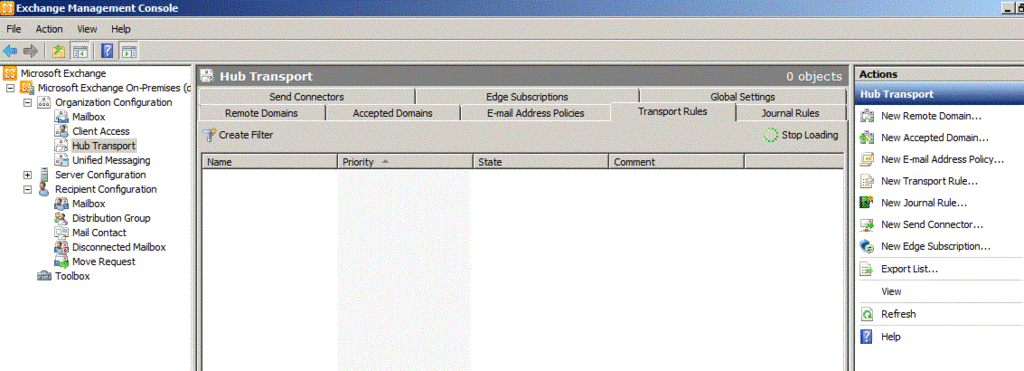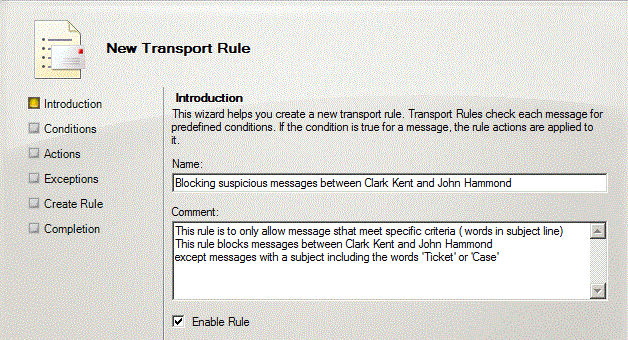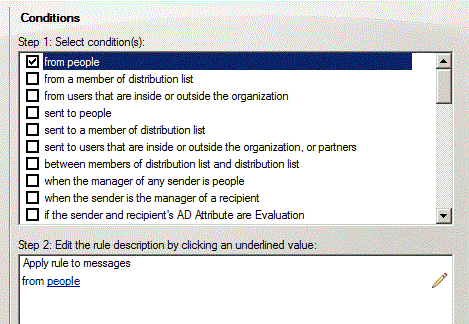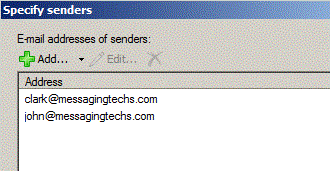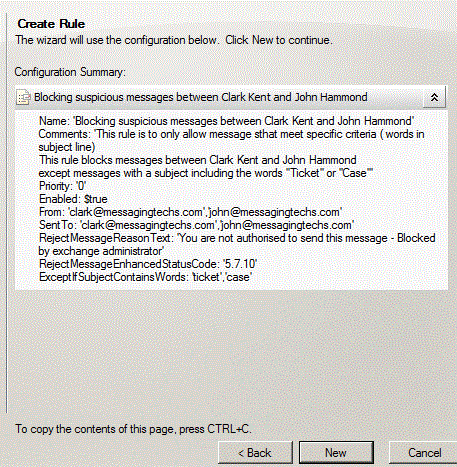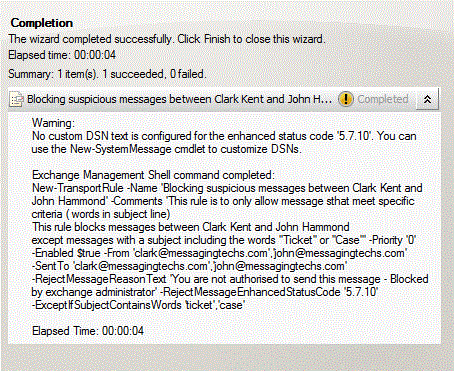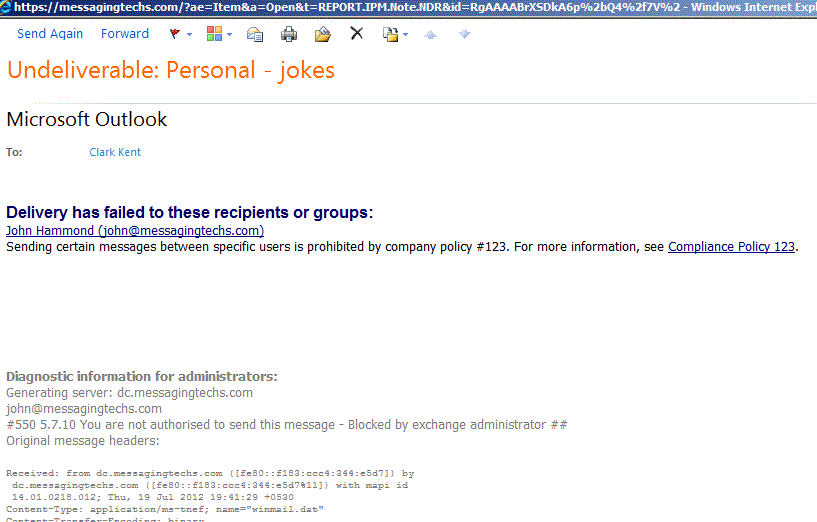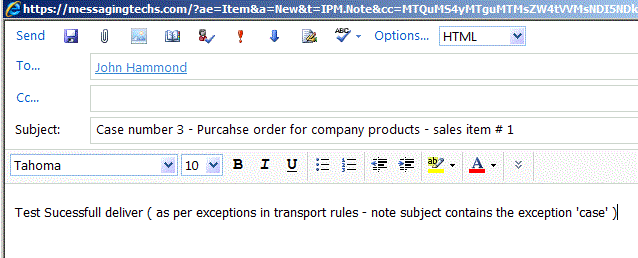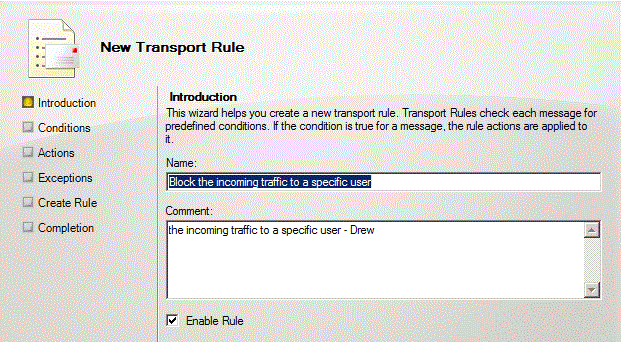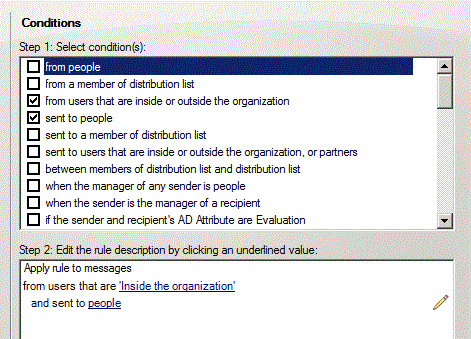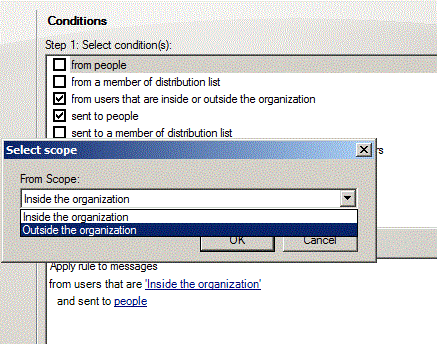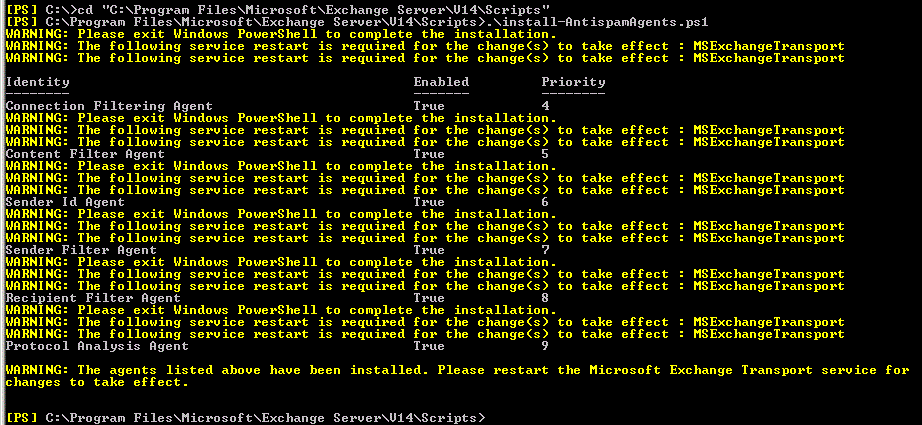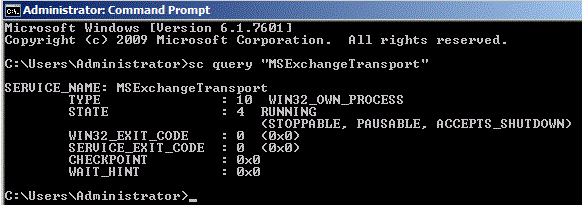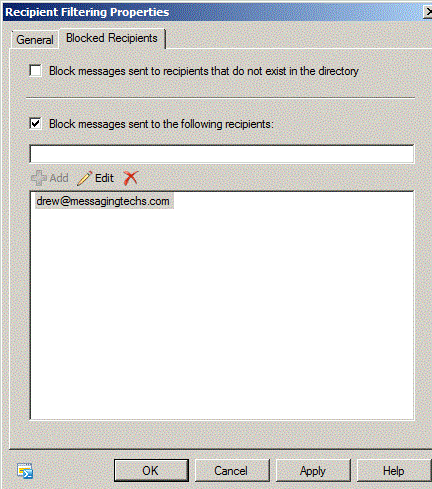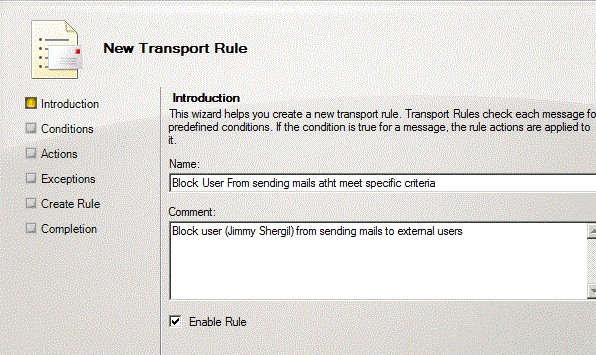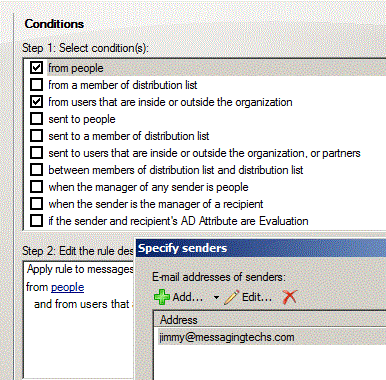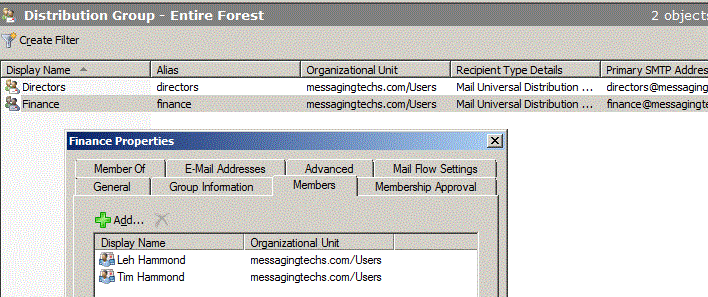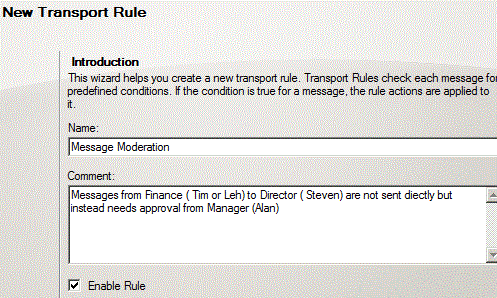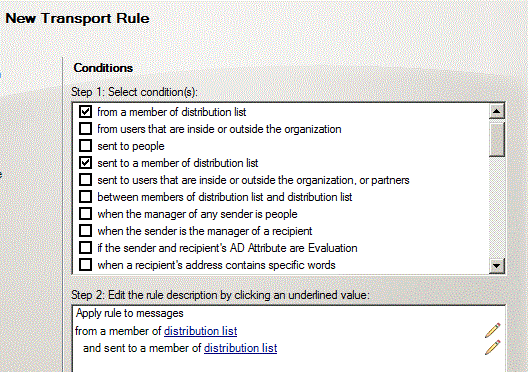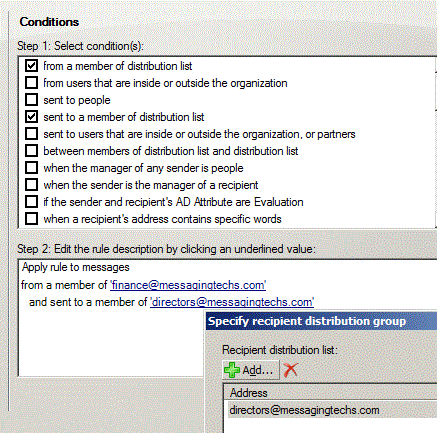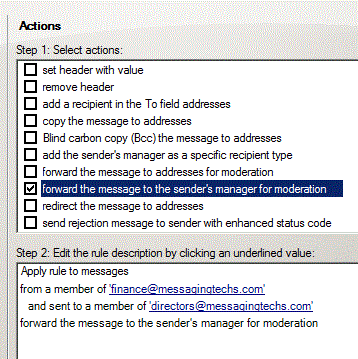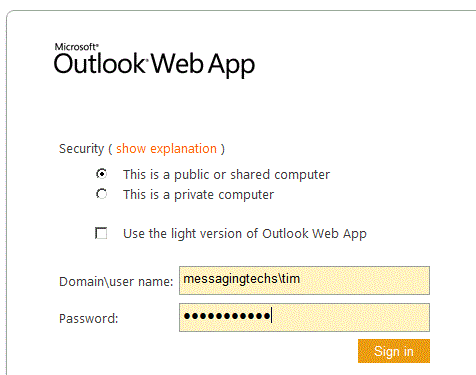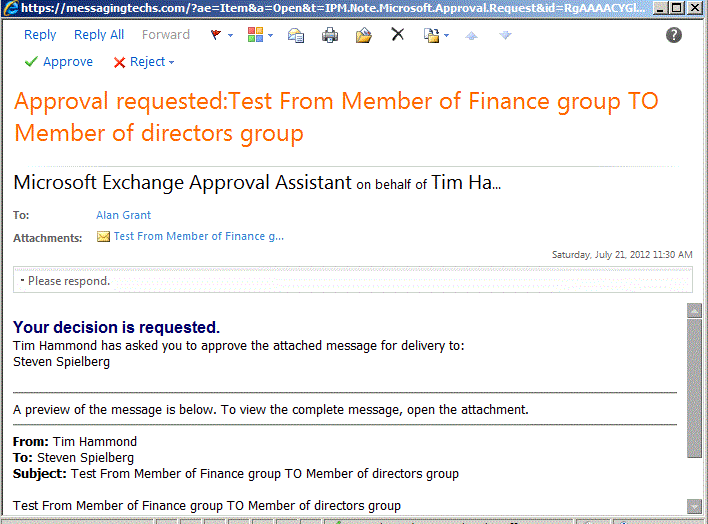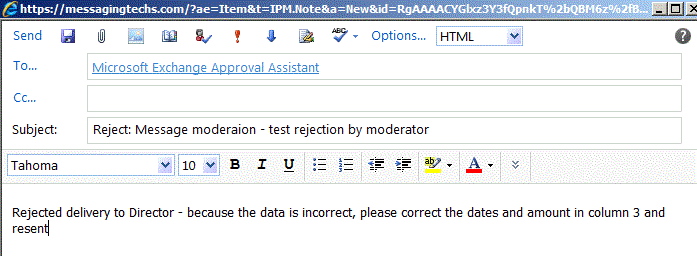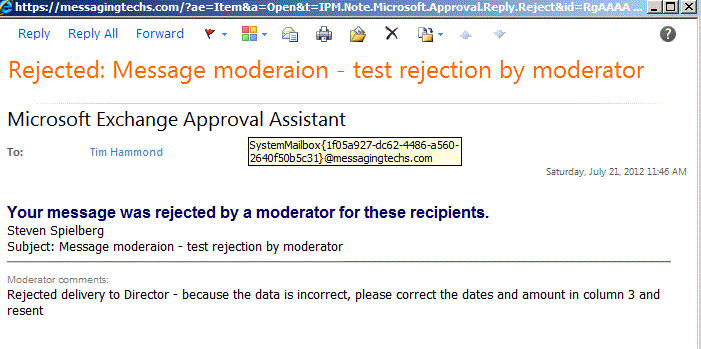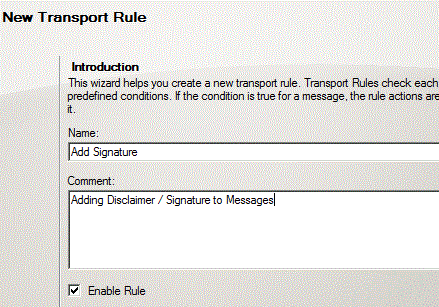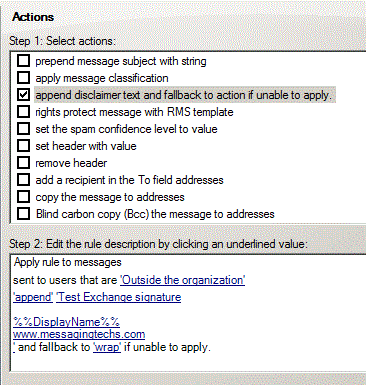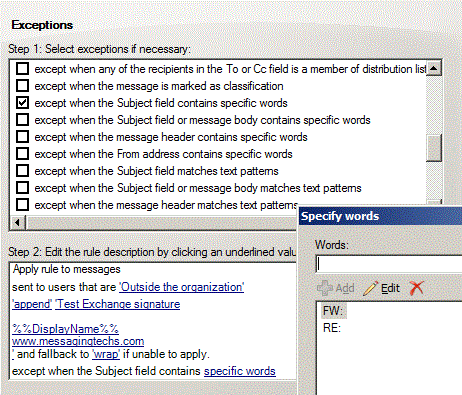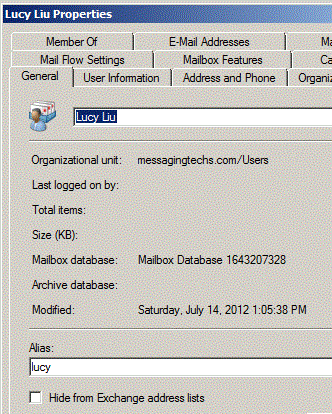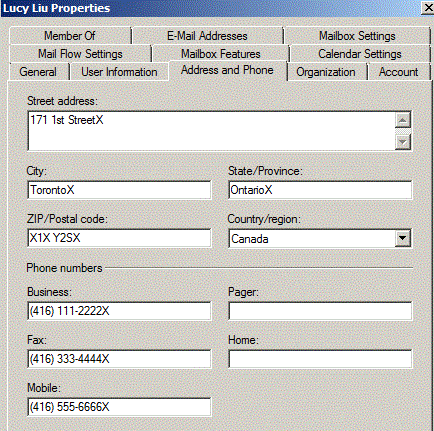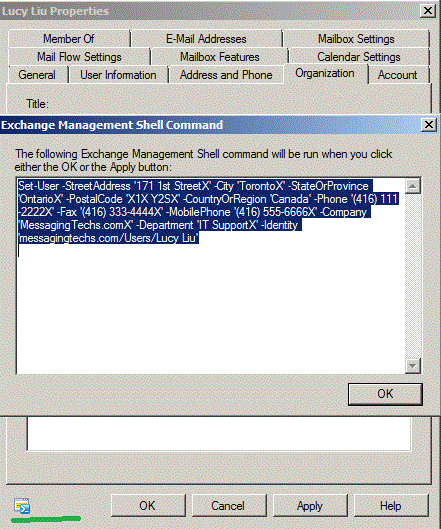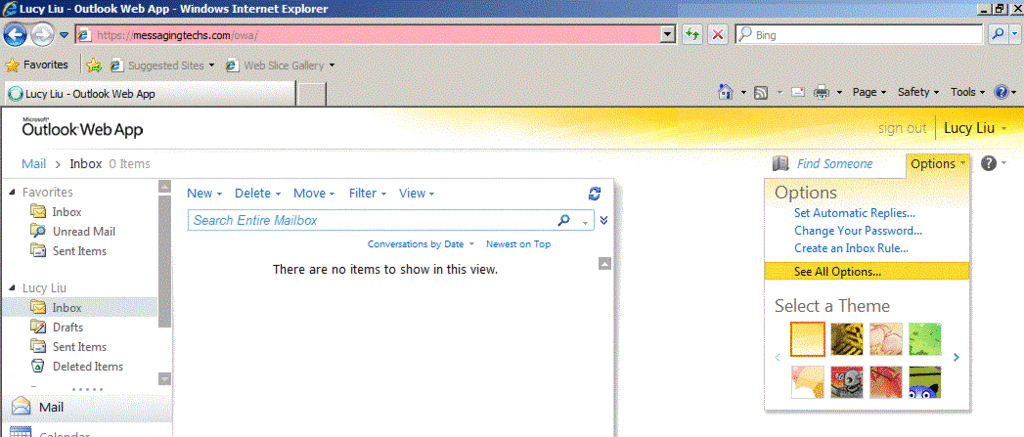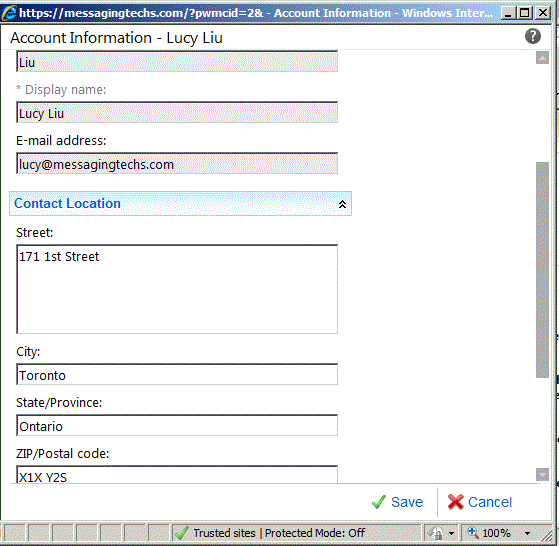Post by David on Jul 17, 2012 16:03:12 GMT 5.5
Transport Rules

Transport rules let you apply messaging policies to e-mail messages that flow through the transport pipeline on Hub Transport and Edge Transport servers. These rules allow information technology (IT) administrators to comply with messaging policies, secure messages, protect messaging systems, and prevent information leakage.
Transport Rule Components
Conditions : Transport rule conditions are used to identify messages to which a transport rule action should be applied. Conditions consist of one or more predicates that specify the parts of a message that should be examined. Some predicates examine message fields or headers, such as To, From, or Cc. Other predicates examine message characteristics such as message subject, body, attachments, message size, and message classification. Most predicates require that you specify a comparison operator, such as equals, doesn't equal, or contains, and a value to match
This example returns all available predicates for transport rules used with the Transport Rules agent.
This example retrieves the single predicate SubjectMatches. The command is piped to the Format-List command to display detailed transport rule predicate information.
Exceptions :
Exceptions override conditions and prevent actions from being applied to an e-mail message, even if the message matches all configured conditions.
Exceptions are based on the same predicates used to build transport rule conditions. However, unlike conditions, exceptions identify messages to which transport rule actions shouldn't be applied.
Actions : Actions are applied to messages that match the conditions and don't match any exception defined in the transport rule
Transport rules have many actions available, such as rejecting, deleting, or redirecting messages, adding additional recipients, adding prefixes in the message subject, or inserting disclaimers and personalized signatures in the message body.
This example returns all available transport rule actions for transport rules used with the Transport Rules agent.
This example retrieves a single transport rule action. The command is piped to the Format-List command to display all properties of the transport rule action.
Rules Agents
Transport rules are applied on Hub Transport and Edge Transport servers by transport agents. On the Hub Transport server, rules are applied by the Transport Rules agent. On the Edge Transport server, this is the job of the Edge Rules agent.
Transport Rules Agent
The Transport Rules agent processes transport rules on Hub Transport servers.All messages in an Exchange 2010 organization are touched by at least one Hub Transport server.(Including Messages to and from users in the same Active Directory site, including users with mailboxes on the same Mailbox server)
Transport rules configured on Hub Transport servers are stored in Active Directory, making them accessible to all Hub Transport servers in the organization as the configuration is replicated to all domain controllers across the Active Directory forest. This allows Exchange to consistently apply a single set of rules across the entire organization. Each Hub Transport server queries Active Directory to retrieve the organization's current transport rule configuration and then applies the rules to messages it handles.
Note : Replication of transport rules across an organization is dependent on Active Directory replication. Replication time between Active Directory domain controllers varies depending on the number of Active Directory sites in the organization, slow links, and other factors outside the control of Exchange. When deploying transport rules, consider replication delays.
Edge Rules Agent
The Edge Rules agent processes transport rules on Edge Transport servers.The Edge Transport server, which serves as an e-mail gateway to and from external messaging systems, is the ideal place to apply messaging hygiene and policy to inbound Internet e-mail. Rules applied by the Edge Rules agent can reduce the total number of messages delivered to and processed by Hub Transport servers, and ultimately delivered to recipients. The agent can also help remove any harmful or objectionable message content.Outbound Internet e-mail can also be subjected to similar policy-based scrutiny, and harmful or objectionable content can be prevented from leaving the organization. Additionally, message content can be checked to prevent sensitive information from being leaked outside the organization.
Transport rules configured on Edge Transport servers are stored in Active Directory Lightweight Directory Services (AD LDS), formerly known as Active Directory Application Mode (ADAM), on each Edge Transport server. Rules configured on one Edge Transport server aren't automatically replicated to other Edge Transport servers in your organization, with or without the use of EdgeSync. Depending on your requirements, you may want to configure each Edge Transport server with identical transport rules, or you may want to configure different transport rules on different Edge Transport servers that address the unique e-mail message traffic patterns of each server. To duplicate rule configuration, you can use the Export-TransportRuleCollection and Import-TransportRuleCollection cmdlets.
Export - EXAMPLE 1
--------------------------------------------------------------------------------
This example exports transport rules on an Exchange 2010 Hub Transport or Edge Transport server. Rule data is exported to the variable $file, and then written to the XML file Rules.xml in the C:\MyDocs folder
EXAMPLE 2
--------------------------------------------------------------------------------
This example exports legacy transport rules created in Exchange 2007 using the ExportLegacyRules switch. The cmdlet should be run from an Exchange 2010 Hub Transport server. The exported rules collection can then be imported to Exchange 2010 using the Import-TransportRuleCollection cmdlet.
Import - EXAMPLE 1
--------------------------------------------------------------------------------
This example imports a transport rule collection from the XML file ExportedRules.xml.
Using Exchange Hosted Services
Transport messaging policies are enhanced by or are also available as a service from Microsoft Exchange Hosted Services.
Exchange Hosted Services is a set of four distinct hosted services:
Hosted Filtering, which helps organizations protect themselves from e-mail-borne malware
Hosted Archive, which helps them satisfy retention requirements for compliance
Hosted Encryption, which helps them encrypt data to preserve confidentiality
Hosted Continuity, which helps them preserve access to e-mail during and after emergency situations
These services integrate with any on-premises Exchange servers that are managed in-house or Hosted Exchange e-mail services that are offered through service providers

Transport rules let you apply messaging policies to e-mail messages that flow through the transport pipeline on Hub Transport and Edge Transport servers. These rules allow information technology (IT) administrators to comply with messaging policies, secure messages, protect messaging systems, and prevent information leakage.
- Preventing inappropriate content from entering or leaving the organization
- Filtering confidential organization information
- Tracking or archiving messages that are sent to or received from specific individuals
- Redirecting inbound and outbound messages for inspection before delivery
- Applying disclaimers to messages as they pass through the organization
Transport Rule Components
Conditions : Transport rule conditions are used to identify messages to which a transport rule action should be applied. Conditions consist of one or more predicates that specify the parts of a message that should be examined. Some predicates examine message fields or headers, such as To, From, or Cc. Other predicates examine message characteristics such as message subject, body, attachments, message size, and message classification. Most predicates require that you specify a comparison operator, such as equals, doesn't equal, or contains, and a value to match
This example returns all available predicates for transport rules used with the Transport Rules agent.
Get-TransportRulePredicate
This example retrieves the single predicate SubjectMatches. The command is piped to the Format-List command to display detailed transport rule predicate information.
Get-TransportRulePredicate -Name SubjectMatches | Format-List
Exceptions :
Exceptions override conditions and prevent actions from being applied to an e-mail message, even if the message matches all configured conditions.
Exceptions are based on the same predicates used to build transport rule conditions. However, unlike conditions, exceptions identify messages to which transport rule actions shouldn't be applied.
Actions : Actions are applied to messages that match the conditions and don't match any exception defined in the transport rule
Transport rules have many actions available, such as rejecting, deleting, or redirecting messages, adding additional recipients, adding prefixes in the message subject, or inserting disclaimers and personalized signatures in the message body.
This example returns all available transport rule actions for transport rules used with the Transport Rules agent.
Get-TransportRuleAction
This example retrieves a single transport rule action. The command is piped to the Format-List command to display all properties of the transport rule action.
Get-TransportRuleAction -Name DeleteMessage | Format-List
Rules Agents
Transport rules are applied on Hub Transport and Edge Transport servers by transport agents. On the Hub Transport server, rules are applied by the Transport Rules agent. On the Edge Transport server, this is the job of the Edge Rules agent.
Transport Rules Agent
The Transport Rules agent processes transport rules on Hub Transport servers.All messages in an Exchange 2010 organization are touched by at least one Hub Transport server.(Including Messages to and from users in the same Active Directory site, including users with mailboxes on the same Mailbox server)
Transport rules configured on Hub Transport servers are stored in Active Directory, making them accessible to all Hub Transport servers in the organization as the configuration is replicated to all domain controllers across the Active Directory forest. This allows Exchange to consistently apply a single set of rules across the entire organization. Each Hub Transport server queries Active Directory to retrieve the organization's current transport rule configuration and then applies the rules to messages it handles.
Note : Replication of transport rules across an organization is dependent on Active Directory replication. Replication time between Active Directory domain controllers varies depending on the number of Active Directory sites in the organization, slow links, and other factors outside the control of Exchange. When deploying transport rules, consider replication delays.
Edge Rules Agent
The Edge Rules agent processes transport rules on Edge Transport servers.The Edge Transport server, which serves as an e-mail gateway to and from external messaging systems, is the ideal place to apply messaging hygiene and policy to inbound Internet e-mail. Rules applied by the Edge Rules agent can reduce the total number of messages delivered to and processed by Hub Transport servers, and ultimately delivered to recipients. The agent can also help remove any harmful or objectionable message content.Outbound Internet e-mail can also be subjected to similar policy-based scrutiny, and harmful or objectionable content can be prevented from leaving the organization. Additionally, message content can be checked to prevent sensitive information from being leaked outside the organization.
Transport rules configured on Edge Transport servers are stored in Active Directory Lightweight Directory Services (AD LDS), formerly known as Active Directory Application Mode (ADAM), on each Edge Transport server. Rules configured on one Edge Transport server aren't automatically replicated to other Edge Transport servers in your organization, with or without the use of EdgeSync. Depending on your requirements, you may want to configure each Edge Transport server with identical transport rules, or you may want to configure different transport rules on different Edge Transport servers that address the unique e-mail message traffic patterns of each server. To duplicate rule configuration, you can use the Export-TransportRuleCollection and Import-TransportRuleCollection cmdlets.
Export - EXAMPLE 1
--------------------------------------------------------------------------------
This example exports transport rules on an Exchange 2010 Hub Transport or Edge Transport server. Rule data is exported to the variable $file, and then written to the XML file Rules.xml in the C:\MyDocs folder
$file = Export-TransportRuleCollection
Set-Content -Path "C:\MyDocs\Rules.xml" -Value $file.FileData -Encoding Byte
Set-Content -Path "C:\MyDocs\Rules.xml" -Value $file.FileData -Encoding Byte
EXAMPLE 2
--------------------------------------------------------------------------------
This example exports legacy transport rules created in Exchange 2007 using the ExportLegacyRules switch. The cmdlet should be run from an Exchange 2010 Hub Transport server. The exported rules collection can then be imported to Exchange 2010 using the Import-TransportRuleCollection cmdlet.
$file = Export-TransportRuleCollection -ExportLegacyRules
Set-Content -Path "C:\MyDocs\LegacyRules.xml" -Value $file.FileData -Encoding Byte
Set-Content -Path "C:\MyDocs\LegacyRules.xml" -Value $file.FileData -Encoding Byte
Import - EXAMPLE 1
--------------------------------------------------------------------------------
This example imports a transport rule collection from the XML file ExportedRules.xml.
[Byte[]]$Data = Get-Content -Path "C:\TransportRules\ExportedRules.xml" -Encoding Byte -ReadCount 0
Import-TransportRuleCollection -FileData $Data
Import-TransportRuleCollection -FileData $Data
Using Exchange Hosted Services
Transport messaging policies are enhanced by or are also available as a service from Microsoft Exchange Hosted Services.
Exchange Hosted Services is a set of four distinct hosted services:
Hosted Filtering, which helps organizations protect themselves from e-mail-borne malware
Hosted Archive, which helps them satisfy retention requirements for compliance
Hosted Encryption, which helps them encrypt data to preserve confidentiality
Hosted Continuity, which helps them preserve access to e-mail during and after emergency situations
These services integrate with any on-premises Exchange servers that are managed in-house or Hosted Exchange e-mail services that are offered through service providers

